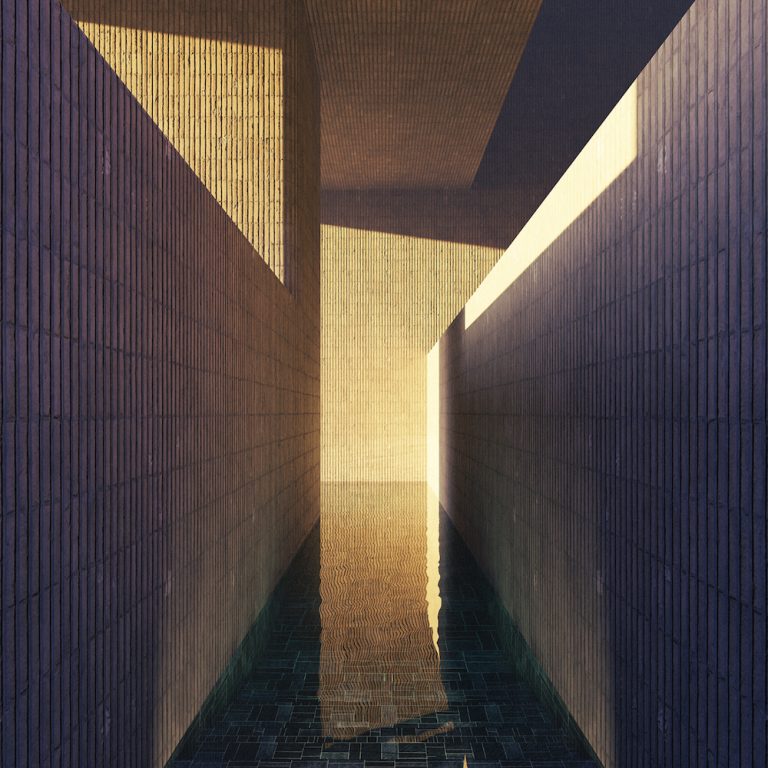Certain audial gestalts seem to correspond with archetypal emo-cognitive states. The “dream” template, for example, captures limbo, betweenness, the neither/nor, ambivalence, purgatory, the mind possibly narcotized but also potently fluid, tapped into the protean nature of experience itself. The “doom” context, on the other hand, conjures peril, how we exist amidst adversarial dynamics, at war with ourselves, others, fate, the God-Satan spectrum. Somewhere between those two genres, perhaps, is the industrial-techno-dance paradigm, a set of gestalts that speaks to the connection between Eros and violence, anxiety and creativity, movement and destruction, the spirit clawing at the cage of the body.
Elaborating on sketches shared via their 2021 EP, Mandy, Indiana now release their full-length debut, i’ve seen a way. There’s no questioning the band’s seamless reconfiguration of sources, including proto-techno tracks such as “Revolution 909” from Daft Punk’s debut; Aphex Twin’s post-ambient work; The Matrix, John Wick, and Run Lola Run soundtracks; the agitated textures and beats of Ministry, NIN, and their industrial/metal heirs; cyber-punk; post-Y2K paranoia; and a brimming archive of international art pop and dance music (gabber, hardvapor, post-Soviet “Berlin”, Goa trance, and hardcore EDM, among other iterations). That is, Mandy, Indiana draw from a notably vital canon, motifs that still course in the collective bloodstream. And, despite its ultimately derivative stance, i’ve seen a way sounds surprisingly au courant.
The Manchester-based quartet, along with many of their predecessors, are successful largely for the way in which they balance adrenalized rebelliousness and dystopian fatalism. Hollywood sci-fi and small-town evangelism alike remind us on a daily basis that the world is coming to an end, and yet the human spirit is indomitable, indeed masterfully designed when it comes to compartmentalization; i.e., there’s no reason to plunge fully into paralytic nihilism. “Drag [Crashed]”, primarily a black ambient and fetishistic sprawl, is also sufficiently dance-y to occur as Eros-affirmative. The track reintroduces us to Valentine Caulfield’s mellifluous yet clipped sprechgesang. Responding in her native French to a noisy and chaotic soundscape, Caulfield sounds like a survivor trying to make her escape from a cordoned-off war zone.
“I’m tired you don’t know what I’m tired of / this shitty world has worn me out / I’ve been broke for years” (a probably bad translation from the French), Caulfield shares on the beat-driven “Pinking Shears”. Brimming with flux, blasts of distorted bass sounds, and cacophonous accents, the track arouses a sense of relentless uncertainty. And yet, as mentioned before, the band never quite sever themselves from the Eros principle. “Injury Detail”, while incorporating the apocalyptic, is also built around a throbbing rhythm that prompts movement, expression, assertion. In other words, this music points to the entropic nature of contemporary life yet is also strikingly aphrodisiacal.
“The Driving Rain (18)” draws as much from drum and bass templates and chorale metal a la Liturgy’s recent work as it does Stereolab, albeit cycled through a series of glitchy filters. The piece evokes a stormy night in some European city that hasn’t recovered from the nightmares of WW2 and myriad dictatorial regimes as consummately as one might think. And yet, the ties to house euphonics, Main-Street club vibes, and prime-time rave infuse the track with an ebullient quality, the band exploring fundamental sonic and energetic paradoxes.
“2 Stripe”, on the other hand, veers back toward the nightmare handbook, Caulfield’s vocal reverberating as if she’s issuing a bullhorn announcement in a fallout shelter or the hallway of a rogue lab where genetic experiments go on behind locked doors (think The Boys from Brazil, Bourne Identity, Manchurian Candidate). As the piece unfolds, the band demonstrate their gift for incorporating melodic elements into noise-sprawls, again signifying that traces of pulchritude can/do exist within even the most ravaged landscapes. Though the world may be a savage place, the Romantic impulse is encouraged; beauty has been acknowledged; and yet, as the piece nears its end, it further illustrates that one can’t cling to pleasure or even love; these Forms, to upend the Platonic term, are ephemeral, glimpses of blue appearing in a nuclear sky.
“Peach Fuzz” is built around repetitive waves of synthy bass undergirded by metronomic beats. Caulfield breathes heavily into the mix, as if panicked, while various accents are added. The band again bridge opposites – between desperation and resilience, catatonia and revolution, anhedonia and the manic yearning that arises when reality is embraced, when denial drops like a tinted screen. i’ve seen a way closes with the militaristic “Sensitivity Training”, opening beats, clangs, and textures recalling timeless campaigns, soldiers clashing with spears, swords, guns; monomaniacal autocrats wowing masses of wide-eyed people gathered in bulging stadiums; throngs of brainwashed individuals marching into members-only warehouses to stuff their carts with supersized products, propping the global economy, even as it sputters and stumbles.
Life is as fragile as ever, and Mandy, Indiana employ an array of beats, accents, tempos, and textures to demonstrate that yes, the end of the world is still coming. And yet, until that final moment arrives, we’re compelled by our genetic history and psychic DNA to celebrate the human spirit, the urge for communion, transcendence… While i’ve seen a way naturally suggests an atheistic vision, it also ironically reaches for something eternal that exists beyond the horrific tortuosities of sociopolitical evolution. Life, God, Spirit, The Way… Mandy, Indiana never lose sight of their aesthetic and existential north star, despite how convincingly they navigate despair.

